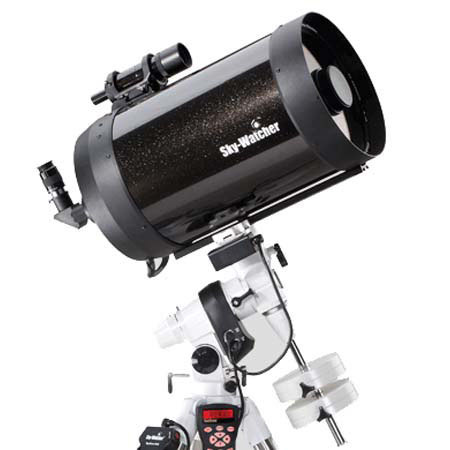
This item is no longer available.
Review Summary
Schmidt-Cassegrain
Mirrors: LTEG; Corrector: Water White Glass
279mm
2800mm
f/10
95mm
660x
14
.50 arc sec
8x50 Viewfinder
1.25", 2" optional
1.25"
1.25" Super Plossl 32mm and 10mm
Equatorial
Computer micro-slewing
3 x 11 lbs
Standard
Micro-step stepper
SynScan
24" long
34" to 40"
27.5 lbs
Sky-Watcher warranty
812556010514
The Sky-Watcher EQ5P 11SCT is a Schmidt-Cassegrain Telescope. As a single component, the 11" optical tube is easily manageable as is the mount and tripod. Compared to a 10", 11", or 12" one piece, fork-mounted SCT design, the SW 11" is vastly more manageable to lift, set up and transport. A perfect example of why the equatorial mount has the advantage in enabling individual amateur astronomers to comfortably operate larger aperture telescopes.
If you have ever lifted a large one-piece fork-mounted SCT a half dozen times, or so, you will appreciate the difference. Incredible indeed are the highly resolved images to be viewed or photographed through this advanced observatory-class instrument. You will see a lot more in a SW 11" SCT compared to smaller 8" and even 10" telescopes at limiting visual magnitude. Diffuse emission nebulae in the summer sky like the Lagoon (M8), Trifid (M20) and Swan (M17); the stunning globular star clusters M13 and M92 in Constellation Hercules; the Rosette Nebula in Monoceros shows the discernable pattern of a blooming rose; the awesome winter sky's Great Orion Nebula (M42) in Constellation Orion and the local galaxy group companion the Andromeda Galaxy (M31) in Constellation Andromeda, to name a very few, will appear more spectacular, brilliant and wider in extension as seen in a SW 11" SCT.
The Moon almost takes on a feeling of viewing in 3D. Subtle discontinuities, ripples and festoons in Jupiter's bands present themselves in bold relief against surrounding Jovian landscape. Saturn's inner crepe-ring is clearly discernable. Martian polar-regions and surface mottling is presented with clarity impossible to experience with a smaller aperture telescope. In addition to the objects listed above, challenging phenomenon for an 8" and perhaps a 10" aperture now come into their own with the SW 11": the planetary nebula the Crab (M1), a supernova remnant, requires a least a10" aperture to truly begin to appreciate the several subtle, gaseous filamentary structures, but it will look even better in an 11".
M15 a globular star cluster challenging to view in smaller telescopes will resolve almost in its entirety into thousands of stars. M101 is a very beautiful faint spiral galaxy often difficult to see. With the SW 11" light-gathering power, it is a lot easier to find than M27, the Dumbell, or Hourglass Nebula in constellation Vulpecula resembles an hour glass in a large telescope. M51, the Whirlpool Galaxy, displays remarkable greater structural detail in an 11" aperture vs. an 8"or even a 10" diameter telescope. There is no question you will find the incremental resolving power of a SW 11" SCT impressive.